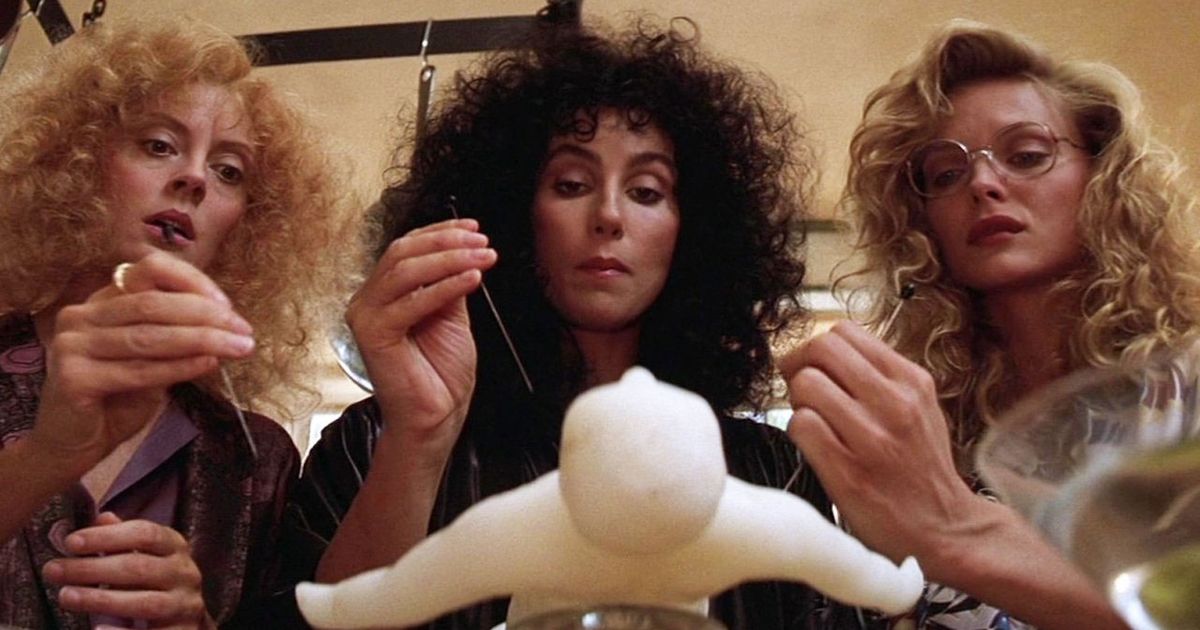💫 The Devil’s Echo: The Witches of Eastwick 2 (2026)

There are films that end — and there are films that linger, humming through the decades like an incantation that never quite fades. The Witches of Eastwick 2 (2026) is the latter: a return not out of nostalgia, but of necessity. Four decades after that fateful storm that seduced, scorched, and liberated Eastwick, the witches rise again — older, sharper, and infinitely more dangerous. What once was mischief is now mastery. What once was temptation is now truth.

Cher, Susan Sarandon, and Michelle Pfeiffer reunite as Alex, Jane, and Sukie — women who have learned that the true cost of power is not in the gaining, but in the keeping. Age has only refined them: Cher’s Alex now exudes regal confidence, her gaze knowing yet haunted; Sarandon’s Jane carries serenity tinged with guilt; Pfeiffer’s Sukie glows with maternal warmth turned steel. They have outlasted the devil himself — but time, as always, conjures its own demons.
Eastwick, once a sleepy coastal town, now pulses with unease. Shadows linger a beat too long. Winds whisper names long dead. The film opens with a funeral — a beloved figure gone, but the air thick with unfinished business. When crows begin to circle and clocks stop at midnight, the coven knows: something — or someone — has come home.

Enter Lucien Black, played with sinuous magnetism by Bill Skarsgård. His arrival feels less like a meeting than a memory — a flicker of something wicked that refuses to die. He is charm distilled into danger, his smile both invitation and omen. Lucien doesn’t seduce with promises; he seduces with understanding. “You don’t need the devil,” he murmurs, “you only need permission.” The brilliance of Skarsgård’s performance lies in restraint — he is not Daryl Van Horne reborn, but his echo, his consequence, a manifestation of desire itself.
With him come two luminous newcomers: Emma Stone as Evie and Anya Taylor-Joy as Luna — two women from different worlds, drawn to Eastwick by dreams they can’t explain. Their chemistry is electric, their curiosity dangerous. When they encounter the elder witches, what begins as mentorship spirals into mirror-work — the young reflecting what the old once were, the old seeing in the young the hunger they’ve long denied. Together, they form an uneasy lineage: three generations of witches standing at the edge of power, temptation, and rebirth.
The script dances on the knife-edge between humor and horror, just as the original did. The wit is biting, the sensuality intoxicating, and the dread slow and deliberate — like a candle burning too close to the drapes. One moment, the women trade quips over martinis; the next, they’re performing a séance that cracks the air with thunder. The tonal alchemy is masterful — dark comedy giving way to gothic revelation, laughter blending with lightning.

Visually, The Witches of Eastwick 2 is sumptuous. Eastwick itself is a character again — its colonial charm now layered with decay and modern sin. Golden autumn hues melt into bruised purples and silvers, as if the world itself were bewitched. Every frame looks painted by moonlight; every spell feels tangible, smoky, and sensual. The production design honors the lush theatricality of the original while evolving into something bolder — more mythic.
Cher commands the film’s moral center. Her Alex, once fiery and impulsive, now moves like a queen who knows the taste of loss. Her dialogue is laced with irony and ache — “We thought we escaped him,” she tells Jane, “but power doesn’t let you go. It remembers who you were.” Sarandon’s performance hums with spiritual weariness, while Pfeiffer’s maternal tenderness becomes her weapon. Their sisterhood, frayed but unbroken, forms the soul of the film — women confronting not just evil, but the echoes of their own desire.
Stone and Taylor-Joy shine as the new bearers of Eastwick’s curse — radiant, reckless, and utterly magnetic. Their bond shifts from mentorship to rivalry to something deeper and more dangerous, exploring generational power dynamics with sharp feminist precision. When Evie and Luna realize that magic, like inheritance, always demands a price, the story transforms from dark comedy into mythic tragedy.

The final act is a crescendo of beauty and destruction. Storms gather. The church bells toll backwards. Lucien’s true nature is revealed — not the devil reborn, but the embodiment of the chaos the witches once unleashed. The climactic ritual — five women standing in a circle of fire and marigold, chanting against their own creation — is pure cinematic rapture. The wind roars, the earth trembles, and Eastwick itself seems to hold its breath.
When dawn breaks, nothing is as it was. The town sleeps again, but magic hums in the air — restless, waiting. The closing line, whispered by Cher as the camera pulls skyward, seals the spell: “Magic doesn’t die. It just changes hands.”
The Witches of Eastwick 2 (2026) is that rare sequel that deepens the legend instead of repeating it — a lush, wicked, and wise reflection on age, desire, and the seductive danger of knowing your own power. It’s not just about witches. It’s about women reclaiming the stories they were once punished for.
Related movies:











